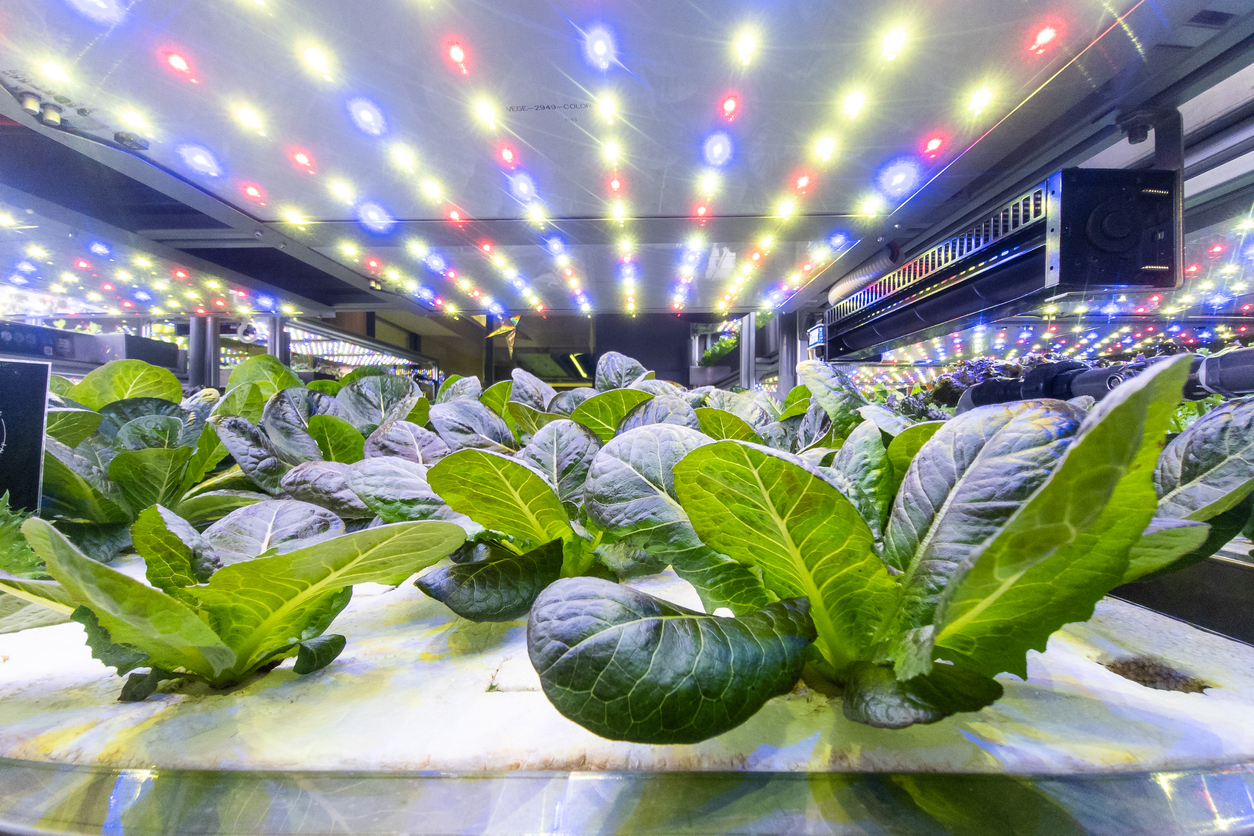
James Prietzel, Product Manager at Intelligent LED Solutions (ILS)
James is the ILS Product Manager for everything related to LEDs and has been with ILS since 2012. James is dedicated to understanding the latest technologies and innovations from leading suppliers in the OptoElectronics world, from optics, to LEDs and to Intelligent LED Drivers.
Horticulture continues to be advanced by LED lighting. New technologies enabled by an ever-expanding knowledge base are demonstrating how plants require different spectral illumination and control. So, how do different LED wavelengths (colours) affect plant growth? Let us explore this.
Firstly, why do plants need light?
All fruit, vegetables, flowers and herbs are impacted by the sun. Plant growth is naturally stimulated by the duration, spectrum and intensity of sunlight. Photon flux density (PFD), which refers to the intensity that photosynthetically active photons hit the surface area of a plant, greatly impacts a plant’s biomass and growth rate. Furthermore, the spectral power distribution, which refers to the energy levels of the light source, has been shown to have an impact in regulating the morphology and even the colour of certain genotypes of a plant. Finally, the photoperiod, which refers to the timing and duration of light, can effectively regulate the flowering times of certain short-day and long-day plants. These components of light are not exclusive, but they all work together to regulate the overall growth of plants.
Different wavelengths emitted by sunlight contribute to various aspects of plant growth. The plants absorb these useful wavelengths. The spectral composition of the different wavelength regions (blue, green, yellow, red, far red or non-visible UV or IR) is important for the growth, shape, development and flowering (photomorphogenesis) of the plant.

How do plants react to wavelengths?
Plants do not react the same as the human eye, which reacts to light with the short, medium and long photoreceptors allowing us to see in colour. Plants respond to light with carotenoids which are pigments in the plants responsible for red, yellow and orange hues in many fruits and vegetables, and with chlorophyll and phytochromes which regulate their growth. Chlorophyll absorption is linked to photosynthesis and therefore to the growth of the plant. A plant’s phytochromes are sensors which react to the environment and adjust the morphology. The absorption spectrum of the eye is primarily a combination of red, green and blue however a plant will respond differently to wavelengths within the range of 280-800nm.

So plants absorption of wavelengths from either a natural or an artificial source, directly impact upon its growth and appearance. Therefore, it is key to understand what impact different wavelengths have on plants, and why we use the LED colours that we do.

How do plants respond to different light wavelengths / colours?

Wavelengths 450nm (deep blue) and 660nm (hyper red) both provide energy for the plant. But the blue light, which is absorbed by cryptochrome within plants, is also responsible for photomorphogenic functions such as stomatal control, stem elongation, and phototropism. While a ratio of red to far‐red light is detected by phytochromes and stimulates stress responses such as elongation growth, apical dominance and flowering.
Far red 730nm LEDs can be used to influence the height of the plant. Exposing a plant to more of this colour wavelength, makes the plant feel like it is in the shadow of a bigger plant, which then triggers the “shade escape reaction” meaning that the plants growth rate is increased. This wavelength can also influence when a plant’s flowers bloom. It can make a plant’s flowers bloom in winter or even prevent them from blossoming in summer.
Although light in the green wavelength range is not easily absorbed and is generally assumed to have a lesser effect on plant growth and photosynthesis, some research has indicated that mixing 24% of green fluorescent LED light (500 to 600 nm) with red and blue LEDs (630 and 470 nm respectively) produces more biomass than other wavelength mixes. This may be because green light can penetrate lower than red or blue light in the plant canopy allowing the lower plant leaves to use the green light for photosynthesis.
Common LED colour combinations
Key colour wavelengths can be paired together to create optimum LED recipes. Different plant types require different light mixes and by identifying what these optimum LED recipes are, growing performance and plant quality can be improved upon. For example as the below table shows, a combination of blue and red wavelengths is ideal for leafy green plant types because they provide energy to the plant and prompt leafy biomass growth.

With greater understanding of the relationship between light wavelengths and the effect on growth and morphology, LEDs can also be used to control the spectral composition of light quality and quantity, thereby reducing energy usage and preventing the undesirable effects of certain regions of the light spectrum.
Horticultural lighting techniques using coloured LEDs
Coloured LEDs can be utilised in various ways in horticulture, depending on the sort of lighting application and what the end goal is. Here are just a few horticultural lighting techniques:
- Supplemental Lighting – Used to supplement pre-existing natural daylight, in order to enhance photosynthesis and thereby improve growth and quality of plants. Often used in greenhouse settings. Coloured LEDs are perfect for supplemental applications, as increasing quantities of key wavelengths the plants receive, can help give them a boost.
- Photoperiodic Lighting – Used to control the light period by extending the natural day length with artificial light. Useful to extend growth periods during winter months for example, when the hours of daylight are shortened
- Cultivation without daylight (non-supplemental) – Used to totally replace daylight with artificial light for ultimate climate control. Although for this application, white LEDs may also be required as well as colour LEDs, in order to make up for the wavelengths the plants would be missing out on due to the lack of natural sunlight.
IHS offer a variety of Horticultural LED modules, using quality LED components from amsOSRAM. Available in variety of size PCBs, and colour wavelengths. For any enquiries please contact +44 (0) 1635 294606 or info@i-hled.co.uk or refer to their website.












